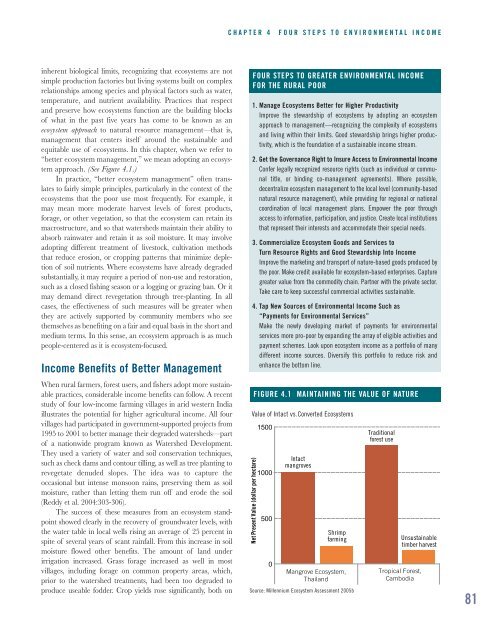jp8589 WRI.qxd - World Resources Institute
jp8589 WRI.qxd - World Resources Institute
jp8589 WRI.qxd - World Resources Institute
Create successful ePaper yourself
Turn your PDF publications into a flip-book with our unique Google optimized e-Paper software.
CHAPTER 4<br />
FOUR STEPS TO ENVIRONMENTAL INCOME<br />
inherent biological limits, recognizing that ecosystems are not<br />
simple production factories but living systems built on complex<br />
relationships among species and physical factors such as water,<br />
temperature, and nutrient availability. Practices that respect<br />
and preserve how ecosystems function are the building blocks<br />
of what in the past five years has come to be known as an<br />
ecosystem approach to natural resource management—that is,<br />
management that centers itself around the sustainable and<br />
equitable use of ecosystems. In this chapter, when we refer to<br />
“better ecosystem management,” we mean adopting an ecosystem<br />
approach. (See Figure 4.1.)<br />
In practice, “better ecosystem management” often translates<br />
to fairly simple principles, particularly in the context of the<br />
ecosystems that the poor use most frequently. For example, it<br />
may mean more moderate harvest levels of forest products,<br />
forage, or other vegetation, so that the ecosystem can retain its<br />
macrostructure, and so that watersheds maintain their ability to<br />
absorb rainwater and retain it as soil moisture. It may involve<br />
adopting different treatment of livestock, cultivation methods<br />
that reduce erosion, or cropping patterns that minimize depletion<br />
of soil nutrients. Where ecosystems have already degraded<br />
substantially, it may require a period of non-use and restoration,<br />
such as a closed fishing season or a logging or grazing ban. Or it<br />
may demand direct revegetation through tree-planting. In all<br />
cases, the effectiveness of such measures will be greater when<br />
they are actively supported by community members who see<br />
themselves as benefiting on a fair and equal basis in the short and<br />
medium terms. In this sense, an ecosystem approach is as much<br />
people-centered as it is ecosystem-focused.<br />
Income Benefits of Better Management<br />
When rural farmers, forest users, and fishers adopt more sustainable<br />
practices, considerable income benefits can follow. A recent<br />
study of four low-income farming villages in arid western India<br />
illustrates the potential for higher agricultural income. All four<br />
villages had participated in government-supported projects from<br />
1995 to 2001 to better manage their degraded watersheds—part<br />
of a nationwide program known as Watershed Development.<br />
They used a variety of water and soil conservation techniques,<br />
such as check dams and contour tilling, as well as tree planting to<br />
revegetate denuded slopes. The idea was to capture the<br />
occasional but intense monsoon rains, preserving them as soil<br />
moisture, rather than letting them run off and erode the soil<br />
(Reddy et al. 2004:303-306).<br />
The success of these measures from an ecosystem standpoint<br />
showed clearly in the recovery of groundwater levels, with<br />
the water table in local wells rising an average of 25 percent in<br />
spite of several years of scant rainfall. From this increase in soil<br />
moisture flowed other benefits. The amount of land under<br />
irrigation increased. Grass forage increased as well in most<br />
villages, including forage on common property areas, which,<br />
prior to the watershed treatments, had been too degraded to<br />
produce useable fodder. Crop yields rose significantly, both on<br />
FOUR STEPS TO GREATER ENVIRONMENTAL INCOME<br />
FOR THE RURAL POOR<br />
1. Manage Ecosystems Better for Higher Productivity<br />
Improve the stewardship of ecosystems by adopting an ecosystem<br />
approach to management—recognizing the complexity of ecosystems<br />
and living within their limits. Good stewardship brings higher productivity,<br />
which is the foundation of a sustainable income stream.<br />
2. Get the Governance Right to Insure Access to Environmental Income<br />
Confer legally recognized resource rights (such as individual or communal<br />
title, or binding co-management agreements). Where possible,<br />
decentralize ecosystem management to the local level (community-based<br />
natural resource management), while providing for regional or national<br />
coordination of local management plans. Empower the poor through<br />
access to information, participation, and justice. Create local institutions<br />
that represent their interests and accommodate their special needs.<br />
3. Commercialize Ecosystem Goods and Services to<br />
Turn Resource Rights and Good Stewardship Into Income<br />
Improve the marketing and transport of nature-based goods produced by<br />
the poor. Make credit available for ecosystem-based enterprises. Capture<br />
greater value from the commodity chain. Partner with the private sector.<br />
Take care to keep successful commercial activities sustainable.<br />
4. Tap New Sources of Environmental Income Such as<br />
“Payments for Environmental Services”<br />
Make the newly developing market of payments for environmental<br />
services more pro-poor by expanding the array of eligible activities and<br />
payment schemes. Look upon ecosystem income as a portfolio of many<br />
different income sources. Diversify this portfolio to reduce risk and<br />
enhance the bottom line.<br />
Value Value of Intact of Intact vs.Converted Converted Ecosystems Ecosystems<br />
Net Present Value (dollar per hectare)<br />
FIGURE 4.1 MAINTAINING THE VALUE OF NATURE<br />
1500<br />
1000<br />
500<br />
0<br />
Intact<br />
mangroves<br />
Shrimp<br />
farming<br />
Mangrove Ecosystem,<br />
Thailand<br />
Source: Millennium Ecosystem Assessment 2005b<br />
Traditional<br />
forest use<br />
Unsustainable<br />
timber harvest<br />
Tropical Forest,<br />
Cambodia<br />
81

















